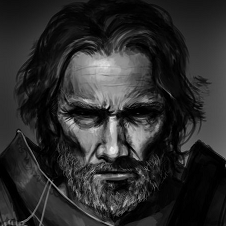-
Posts
38,423 -
Joined
-
Last visited
Content Type
Profiles
Forums
Events
Gallery
Everything posted by Ace-Garageguy
-
Thanks guys. i just buried the rear bellypan in SEM high-build buff, and shot a couple more coats of scratch-filler PlastiKote gray on the upper body. Details are crispening up, but I'm going to let her shrink in all work-week. I'm getting a little antsy wanting to see her in paint now...and that's the time to put on the brakes. This is really an exercise in self-discipline for me, 'cause normally I would have put her to the side and started on something else weeks ago, when the build got a little more involved than I'd originally anticipated. I thought this was going to be a relative "quickie", just to get one actually finished.
-

DECANTING QUESTION - BIG 3 LACQUER-MAKERS
Ace-Garageguy replied to fseva's topic in Model Building Questions and Answers
I've had some Testors enamels bubble mysteriously on occasion if sprayed from the can on to a part. The paint hits, flows out beautifully slick, and then will bubble a bit, but only on a sharp edge. Not contamination, or too-wet spraying of the material, cause I kinda know how to prep and spray. Very odd. The wheels on my heavily re-worked '32 Ford gluebomb are Testors dark red enamel, and 3 of 4 wheels (painted at different times) bubbled only on the outer rims. After assuming contamination and stripping them and re-prepping/re-painting several times, the only way I could get rid of the bubbles was to let the paint cure completely for weeks, and sand / polish the rims...VERY carefully. Hammering the paint on would have resulted in bubbles where the paint was thickest, and pooled...not where it was thin on the sharp edges. At this point, I can only assume this was some odd dissolved-propellant gassing phenomenon...but it still doesn't make much sense. -

Smooth Aluma-Coupester (Chip Foose style build) done!
Ace-Garageguy replied to Kennyboy's topic in Model Cars
Very nice. Gorgeous paint too. -

Deuce 5-W Hiboy- Final Update - May 4
Ace-Garageguy replied to Phildaupho's topic in WIP: Model Cars
Looking good. -
Looking good. Nice thing about the AMT Vicky is that it's the only '32 Ford chassis in the AMT line (well, maybe the Phaeton too) that doesn't have the totally blobular chassis with the rear axle molded in. Though the underside detailing is totally incorrect (there were no plank floors on '32 Fords), it's a decent place to start to build a traditional car nonetheless.
-
Same thing as every day...rampant stupidity and ignorance everywhere...and people who wear their dumb like some kind of badge of honor. Really, everyone is NOT created equal.
-

DECANTING QUESTION - BIG 3 LACQUER-MAKERS
Ace-Garageguy replied to fseva's topic in Model Building Questions and Answers
Most likely. The sudden release of pressure when the paint with dissolved gas in it escapes through the nozzle pretty well triggers the release of all the dissolved gas. Just like the Coke you lick off the floor (after it sprays all over everything when you drop the can) is flat. Spraying the stuff against the wall of a container does the same thing. Really. -

Post your oldest model picture
Ace-Garageguy replied to Scott Colmer's topic in General Automotive Talk (Trucks and Cars)
This is the oldest model I could find. -
This is interesting. I've found several references to the car having been designed by Giorgetto Giugiaro, who also did some very angular cars like the Fiat X1-9. His accomplishments are many and varied, and he's one of my favorite designers. The interesting part is that in the mid-'70s, there was a lot of mindlessly repeated BS concerning his propensity (at the time) to do sharp-edged cars "because he couldn't draw perspective and curves". Probably started by someone a little jealous of his ability. I think that this beautifully voluptuous but elegant design pretty well puts paid to that stupidity.
-
When are twodoors not twodoors? When they're ajar. A jar...get it?? I know, stupid joke.
-
This is kinda a well-known car, being the only convertible coupe built by Pierce in their last year of production. I'd seen it before.
-

Used dragster, update 2 October 2015
Ace-Garageguy replied to MGL's topic in WIP: Drag Racing Models
Good looking work, interesting project concept, frame stretch looks very well done. Couple minor points. A radiator is unnecessary on this, as already noted. As you suspect, the little extra tank is for water. Many drag cars don't even run a pump, but there's no reason not to (other than the loss of power it takes to drive it...which might be worthwhile to preserve the engine a little longer) if you have space on the front of the engine, which you will as you're not running a blower. Electric pumps were in use quite some time ago, and will work if your car carries a battery. Your work on the intake manifold is nice and clean, but the ports on a 440 are not all the way at the ends of the heads as you have them. They are paired, like you have, but the pairs are rather closer together. One more thing...an automatic trans is entirely unnecessary as well. It would only serve as a weak link, add weight, and would probably slow the car down. Lotsa rail jobs run no trans whatsoever...just a flywheel and clutch in a scattershield, and an output shaft to the rear end. A guy on a budget would do well to run some sort of air filter, and on a relatively low horsepower engine like this, it shouldn't make too much flow restriction. Grit in the air can take the rings out of a race engine very quickly, and do enough damage to the cylinders to require an overbore. Not fun if you have limited bucks to race on. -
Sorry that one didn't do you any good. I'm really surprised that, what with all the tons of reference photos of the front-engined Scarabs and even the F1 car, there's almost nothing in detail shots of the mid-engined Mk IV...which you already know. I tried about every search term I could think of, and the one I posted seemed to be about all there is showing any interior detail whatsoever. Good luck. I wonder if the car is featured in any old race-car books. EDIT: I just found this. Maybe it will help you. "There is a very good story on the Rear Engined Scarab in the Nov/Dec 2004 issue of Vintage Motorsport it is 10 pages and has quite a few pictures also. It is called The Last Scarab. " EDIT 2: There's a copy on ebay right now. http://www.ebay.com/itm/2004-Vintage-Motorsport-Magazine-Number-6-Last-Scarab-/111527086676?pt=LH_DefaultDomain_0&hash=item19f7884a54
-

What did you see on the road today?
Ace-Garageguy replied to Harry P.'s topic in General Automotive Talk (Trucks and Cars)
This week: a uniboby Ford pickup, a chopped '49 Ford coupe, and a '40 Ford next to a '41. -
I put the black-primered body in the sun for a couple hours to cook off, then scuffed it with a gray ScotchBrite pad, and shot a couple coats of SEM high-build buff primer over it all. In this scale, it's pretty much like sprayable bondo, and fills 180 grit sand scratches well. Again, let it sun-bake, and sanded it with 400 wet. After sanding, I sprayed a couple of coats of PlastiKote scratch-filler gray primer. Getting close, but still many minor issues to tighten up. It's necessary to re-scribe the panel lines after every primer application, and some of the details are softening from the thick primer. I'll need to sharpen them back up after this coat hardens, and then shoot a couple of coats of sandable, non-high-build white primer. I also have to be very careful of primer buildup on the louvered areas, and that takes a different technique to avoid.
-
Thank you very much. Thank you too, sir. -------------------------------------------------------------- One of my methods for creating finely-sculpted shapes is to tape off areas I want to build up, and only add filler where it's really needed. That worked out well, and the right side now matches the left side...as much as it's gonna. I got ol' Lefty to sit in the car again, this time with the seat installed on the frame rails, just to verify that the driver's head will actually be in the center of the fairing as-built. Things seemed to be close enough to shoot a few coats of SEM self-etching primer. This stuff is really hot, and when shot very wet, really hammered on, it makes the styrene swell somewhat. The bondoed areas don't swell. I use it because it provides exceptional adhesion, and this model will be the plug for a set of body panel molds. I want to do a few takeoffs on this design, but I don't want to do all this work again. I also don't want to have to repaint it after molding, and really good adhesion of the primer is insurance against the finish coming off and sticking to the mold.
-
Beautiful weather here...low humidity, 75 deg.F, no wind. Got the self-etching primer on the '28 Ford / Ardun dry-lakes build, got it sanded and got a couple coats of high-build on too. And somebody gave me a mystery fan they took off of some oddball hot-rod. It turned out to be the one I needed for the '86 Jag XJ-6 (the OEM plastic one exploded and took out the radiator, etc.) So now I may just get her running again and forget about engineering a custom shroud and electric fans for a while.
-
Now THAT sounds like a very good day.
-
Skip's got it exactly right, and you can't beat the old "little pages" and Hot Rod (which was a full-size mag from the beginning IIRC) for getting the straight dope on how it really was. Another drawback to running the old Y-block in anything really hot was a lack of a wide range of serious speed equipment. The odd stacked intake-port layout was not the best possible configuration, either. The Chevy smallblocks caught on because they were light and small for the power they made, and pretty quickly became available in prodigious numbers in junkyards. They also made more power stock than some heavily modded flatheads, so their popularity is no surprise. And because they became so popular, so fast, the aftermarket go-fast guys concentrated on developing parts for the little Chevy...where the biggest potential market was. The wide array of available speed parts further drove the popularity, etc. The formulaic hot-rods all running little Chevy engines do it for the simple reason that it's an engine that fits easily most everywhere, and because of the extreme popularity you can get hop-up parts for it cheaper than just about anything else. Oh yeah...it's also a very VERY good engine.
